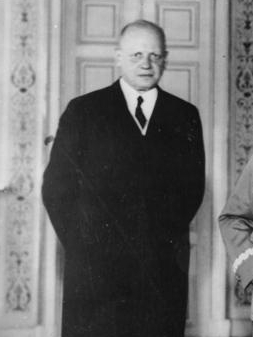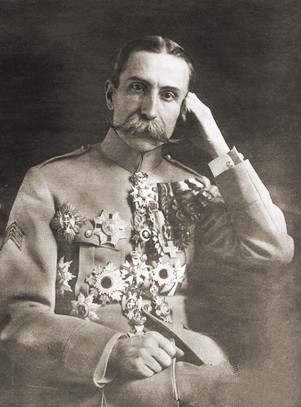|
Hans-Adolf Von Moltke
Hans-Adolf Helmuth Ludwig Erdmann Waldemar von Moltke (29 November 188422 March 1943) was a German landowner in Silesia who became a diplomat. He served as ambassador in Poland during the Weimar Republic. After the German invasion of Poland, he became Adolf Hitler's ambassador in Spain during the Second World War. Early life and career Moltke was born in Oppeln (now Opole), in Upper Silesia, into one of Germany's most famous aristocratic families. Moltke's father, Fredrich von Moltke, served as the Prussian minister of the interior. Moltke was a devout Lutheran and held the standard nationalist and conservative views that were typical of the German aristocracy in the late 19th century. Coming from a family long noted for its service to the Prussia and then Germany, Moltke ascribed to the viewpoint that it was the greatest honour to serve the state and held that view throughout his life. Moltke studied the law from 1903 to 1907 at Heidelberg University and joined the Corps Saxo- ... [...More Info...] [...Related Items...] OR: [Wikipedia] [Google] [Baidu] |
Opole
Opole (; german: Oppeln ; szl, Ôpole) ; * Silesian: ** Silesian PLS alphabet: ''Ôpole'' ** Steuer's Silesian alphabet: ''Uopole'' * Silesian German: ''Uppeln'' * Czech: ''Opolí'' * Latin: ''Oppelia'', ''Oppolia'', ''Opulia'' is a city located in southern Poland on the Oder River and the historical capital of Upper Silesia. With a population of approximately 127,387 as of the 2021 census, it is the capital of Opole Voivodeship (province) and the seat of Opole County. Its built-up (or metro area) was home to 146,522 inhabitants. It is the smallest city in Poland that is also the largest city in its province. Its history dates to the 8th century, and Opole is one of the oldest cities in Poland. An important stronghold in Poland, it became a capital of a duchy within medieval Poland in 1172, and in 1217 it was granted city rights by Duke Casimir I of Opole, the great-grandson of Polish Duke Bolesław III Wrymouth. During the Medieval Period and the Renaissance, the city was ... [...More Info...] [...Related Items...] OR: [Wikipedia] [Google] [Baidu] |
Heidelberg University
} Heidelberg University, officially the Ruprecht Karl University of Heidelberg, (german: Ruprecht-Karls-Universität Heidelberg; la, Universitas Ruperto Carola Heidelbergensis) is a public research university in Heidelberg, Baden-Württemberg, Germany. Founded in 1386 on instruction of Pope Urban VI, Heidelberg is Germany's oldest university and one of the world's oldest surviving universities; it was the third university established in the Holy Roman Empire. Heidelberg is one of the most prestigious and highly ranked universities in Europe and the world. Heidelberg has been a coeducational institution since 1899. The university consists of twelve faculties and offers degree programmes at undergraduate, graduate and postdoctoral levels in some 100 disciplines. The language of instruction is usually German, while a considerable number of graduate degrees are offered in English as well as some in French. As of 2021, 57 Nobel Prize winners have been affiliated with the city o ... [...More Info...] [...Related Items...] OR: [Wikipedia] [Google] [Baidu] |
Henri Le Rond
Henri Le Rond (9 October 1864 – 29 May 1949) was a French General, officer of the Deuxième Bureau and Head of the Inter-Allied Administrative and Plebiscite Commission in Upper Silesia ("C.I.H.S"; French: ''Commission interalliée de gouvernement et de plébiscite de Haute-Silésie''). The commission suggested a plan to divide the region of Upper Silesia in the aftermath of World War I, which led to the cession of East Upper Silesia. Le Rond was born in Rouen as ''Henri Louis Edouard Le Rond''. 1921 he became Grand Officer of the French Legion of Honour, received 1926 the Grand Cross. Later he was awarded with the Czechoslovak Order of the White Lion, the Polish Order of the White Eagle and Order Virtuti Militari, and the Order of Saint-Charles of Monaco. Le Rond died 1949 in Paris Paris () is the Capital city, capital and List of communes in France with over 20,000 inhabitants, most populous city of France, with an estimated population of 2,165,423 residents in 2019 i ... [...More Info...] [...Related Items...] OR: [Wikipedia] [Google] [Baidu] |
Joint Commission For Upper Silesia
A joint or articulation (or articular surface) is the connection made between bones, ossicles, or other hard structures in the body which link an animal's skeletal system into a functional whole.Saladin, Ken. Anatomy & Physiology. 7th ed. McGraw-Hill Connect. Webp.274/ref> They are constructed to allow for different degrees and types of movement. Some joints, such as the knee, elbow, and shoulder, are self-lubricating, almost frictionless, and are able to withstand compression and maintain heavy loads while still executing smooth and precise movements. Other joints such as sutures between the bones of the skull permit very little movement (only during birth) in order to protect the brain and the sense organs. The connection between a tooth and the jawbone is also called a joint, and is described as a fibrous joint known as a gomphosis. Joints are classified both structurally and functionally. Classification The number of joints depends on if sesamoids are included, age of the h ... [...More Info...] [...Related Items...] OR: [Wikipedia] [Google] [Baidu] |
Upper Silesia Plebiscite
The Upper Silesia plebiscite was a plebiscite mandated by the Versailles Treaty and carried out on 20 March 1921 to determine ownership of the province of Upper Silesia between Weimar Germany and Poland. The region was ethnically mixed with both Germans and Poles; according to prewar statistics, ethnic Poles formed 60 percent of the population. Under the previous rule by the German Empire, Poles claimed they had faced discrimination, making them effectively second class citizens. The period of the plebiscite campaign and inter-Allied occupation was marked by violence. There were three Polish uprisings, and German volunteer paramilitary units came to the region as well. The area was policed by French, British, and Italian troops, and overseen by an Inter-Allied Commission. The Allies planned a partition of the region, but a Polish insurgency took control of over half the area. The Germans responded with volunteer paramilitary units from all over Germany, which fought the Polish ... [...More Info...] [...Related Items...] OR: [Wikipedia] [Google] [Baidu] |
Allied Commission
Following the termination of hostilities in World War II, the Allies were in control of the defeated Axis countries. Anticipating the defeat of Germany and Japan, they had already set up the European Advisory Commission and a proposed Far Eastern Advisory Commission to make recommendations for the post war period. Accordingly, they managed their control of the defeated countries through Allied Commissions, often referred to as Allied Control Commissions (ACC), consisting of representatives of the major Allies. Italy Under the provisions of Article 37 in thArmistice with Italy Instrument of Surrender September 29, 1943, the Control Commission for Italy was established on November 10, 1943, and was dismantled on Dicember 14, 1947, following the conclusion of the Italian Peace Treaty at the Paris Peace Conference in 1947. Romania The Armistice Agreement with Rumania signed on September 12, 1944, established, among others, the following: * Article 1 ''"As from August 24, 1944, at f ... [...More Info...] [...Related Items...] OR: [Wikipedia] [Google] [Baidu] |
Rudolf Steiner
Rudolf Joseph Lorenz Steiner (27 or 25 February 1861 – 30 March 1925) was an Austrian occultist, social reformer, architect, esotericist, and claimed clairvoyant. Steiner gained initial recognition at the end of the nineteenth century as a literary critic and published works including ''The Philosophy of Freedom''. At the beginning of the twentieth century he founded an esoteric spiritual movement, anthroposophy, with roots in German idealist philosophy and theosophy. Many of his ideas are pseudoscientific. He was also prone to pseudohistory. In the first, more philosophically oriented phase of this movement, Steiner attempted to find a synthesis between science and spirituality. His philosophical work of these years, which he termed "spiritual science", sought to apply what he saw as the clarity of thinking characteristic of Western philosophy to spiritual questions, differentiating this approach from what he considered to be vaguer approaches to mysticism. In a second pha ... [...More Info...] [...Related Items...] OR: [Wikipedia] [Google] [Baidu] |
Helmuth Von Moltke The Younger
Graf Helmuth Johannes Ludwig von Moltke (; 25 May 1848 – 18 June 1916), also known as Moltke the Younger, was a German general and Chief of the Great German General Staff. He was also the nephew of ''Generalfeldmarschall'' ''Graf'' Helmuth Karl Bernhard von Moltke, who is commonly called "Moltke the Elder" to differentiate the two. Upon becoming the head of the General Staff, Moltke led the German Army from 1 January 1906 to 14 September 1914 during the opening months of World War I. His legacy remains a matter of controversy due to his involvement in Germany's decision to go to war and the execution of the invasion of France and Belgium culminating in the First Battle of the Marne. Early career Helmuth von Moltke was born in Biendorf, Grand Duchy of Mecklenburg-Schwerin, and was named after his uncle, Helmuth Karl Bernhard von Moltke, future ''Generalfeldmarschall'' (Field Marshal) and hero of the Unification of Germany. During the Franco-Prussian War, Moltke served with ... [...More Info...] [...Related Items...] OR: [Wikipedia] [Google] [Baidu] |
Kingdom Of Württemberg
The Kingdom of Württemberg (german: Königreich Württemberg ) was a German state that existed from 1805 to 1918, located within the area that is now Baden-Württemberg. The kingdom was a continuation of the Duchy of Württemberg, which existed from 1495 to 1805. Prior to 1495, Württemberg was a county in the former Duchy of Swabia, which had dissolved after the death of Duke Conradin in 1268. The borders of the Kingdom of Württemberg, as defined in 1813, lay between 47°34' and 49°35' north and 8°15' and 10°30' east. The greatest distance north to south comprised and the greatest east to west was . The border had a total length of and the total area of the state was . The kingdom had borders with Bavaria on the east and south, with Baden in the north, west, and south. The southern part surrounded the Prussian province of Hohenzollern on most of its sides and touched on Lake Constance. History Frederick I Frederick II, the Duke of Württemberg (1754–1816; elev ... [...More Info...] [...Related Items...] OR: [Wikipedia] [Google] [Baidu] |
Stuttgart
Stuttgart (; Swabian: ; ) is the capital and largest city of the German state of Baden-Württemberg. It is located on the Neckar river in a fertile valley known as the ''Stuttgarter Kessel'' (Stuttgart Cauldron) and lies an hour from the Swabian Jura and the Black Forest. Stuttgart has a population of 635,911, making it the sixth largest city in Germany. 2.8 million people live in the city's administrative region and 5.3 million people in its metropolitan area, making it the fourth largest metropolitan area in Germany. The city and metropolitan area are consistently ranked among the top 20 European metropolitan areas by GDP; Mercer listed Stuttgart as 21st on its 2015 list of cities by quality of living; innovation agency 2thinknow ranked the city 24th globally out of 442 cities in its Innovation Cities Index; and the Globalization and World Cities Research Network ranked the city as a Beta-status global city in their 2020 survey. Stuttgart was one of the host cities ... [...More Info...] [...Related Items...] OR: [Wikipedia] [Google] [Baidu] |
Wernersdorf
Wernersdorf is a former municipality in the district of Deutschlandsberg in the Austrian state of Styria. Since the 2015 Styria municipal structural reform The Styria municipal structural reform (German: ''Steiermärkische Gemeindestrukturreform'') was a local government reform in the Austrian state of Styria, which was made effective January 1, 2015. This reform nearly halved the number of Styrian ..., it is part of the municipality Wies. Population References Cities and towns in Deutschlandsberg District {{Styria-geo-stub ... [...More Info...] [...Related Items...] OR: [Wikipedia] [Google] [Baidu] |







